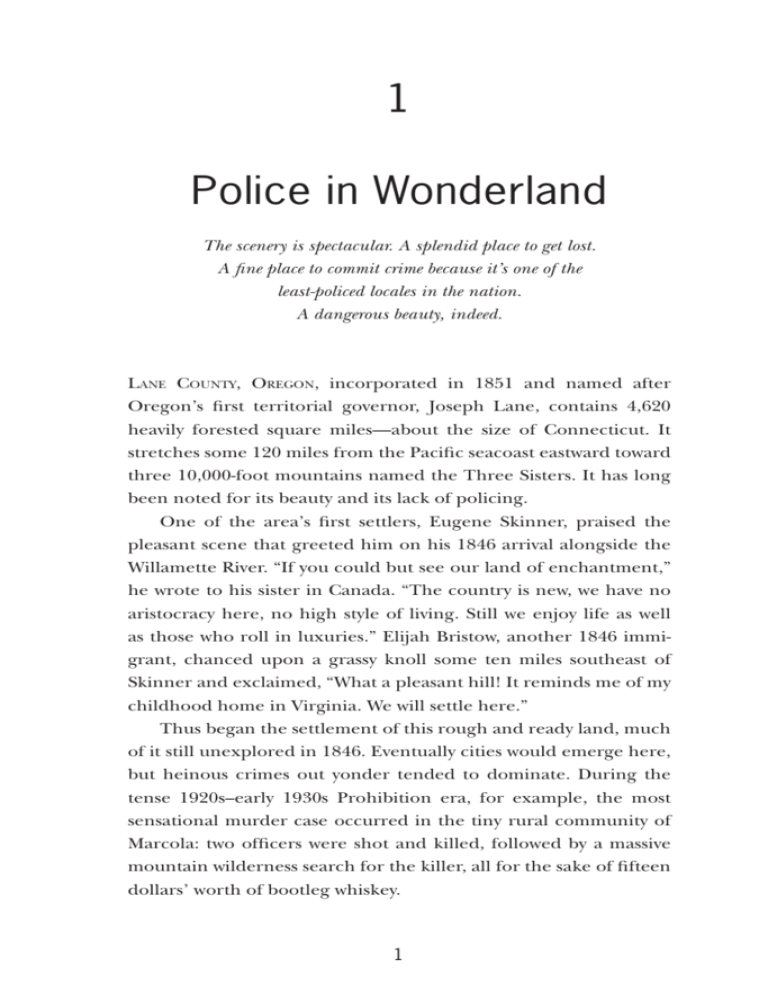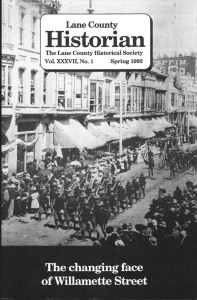1 Police in Wonderland
advertisement

Police in Wonderland 1 1 Police in Wonderland The scenery is spectacular. A splendid place to get lost. A fine place to commit crime because it’s one of the least-policed locales in the nation. A dangerous beauty, indeed. LANE COUNTY, OREGON, incorporated in 1851 and named after Oregon’s first territorial governor, Joseph Lane, contains 4,620 heavily forested square miles—about the size of Connecticut. It stretches some 120 miles from the Pacific seacoast eastward toward three 10,000-foot mountains named the Three Sisters. It has long been noted for its beauty and its lack of policing. One of the area’s first settlers, Eugene Skinner, praised the pleasant scene that greeted him on his 1846 arrival alongside the Willamette River. “If you could but see our land of enchantment,” he wrote to his sister in Canada. “The country is new, we have no aristocracy here, no high style of living. Still we enjoy life as well as those who roll in luxuries.” Elijah Bristow, another 1846 immigrant, chanced upon a grassy knoll some ten miles southeast of Skinner and exclaimed, “What a pleasant hill! It reminds me of my childhood home in Virginia. We will settle here.” Thus began the settlement of this rough and ready land, much of it still unexplored in 1846. Eventually cities would emerge here, but heinous crimes out yonder tended to dominate. During the tense 1920s–early 1930s Prohibition era, for example, the most sensational murder case occurred in the tiny rural community of Marcola: two officers were shot and killed, followed by a massive mountain wilderness search for the killer, all for the sake of fifteen dollars’ worth of bootleg whiskey. 1 2 Dangerous Beauty And when police investigated major auto crashes in this scenic haven, the most egregious examples occurred in the outlying regions. Drivers routinely smashed their vehicles into one another, swerved into rushing rivers, tumbled down steep embankments, or smacked into big trees. Lane County’s worst auto crash occurred in 1946 on a rural route (Highway 99) just south of Junction City. Eight people died when their car collided with a Greyhound bus, whose passengers, remarkably, escaped uninjured. In recent times, auto collisions have killed about thirty to forty persons annually in Lane County, 400 to 500 in Oregon, and about 41,000 to 43,000 in the nation—more than 100 a day on average. How strange to see little American public distress about those casualty tallies. Although police have usually responded promptly to such incidents, Lane County has had a reputation as one of the leastpoliced political entities in the nation. In 2005, the U.S. average was 2.52 police officers per thousand population. California had 2.17, and Oregon 1.9 (ranked forty-second among the fifty states). Lane County had 1.3 per thousand. Most of that policing occurred in the county’s two largest cities, Eugene (named for Eugene Skinner) and Springfield (named for a bubbling spring). Policing in rural Lane County varied over the years, from low to almost none. Citizens have unique problems in this exotic countryside. One frigid winter day a deputy sheriff learned of a stranded hiker at the bottom of Salt Creek Falls, a sheer 286-foot drop near Highway 58 as it crosses Oregon’s Cascade Mountain Range. This day the waterfall glistened with ice, leaving only a trickle of water falling. The deputy rappelled down the icy cliff by rope. He stopped about twenty feet from the bottom. Finding the hiker standing and apparently uninjured, he shouted, “Sir!—do you like cops?” Cops take a subtle delight in that story, which suggests that police serve a public quick to criticize, slow to appreciate. It’s easy to become lost in this enchanting countryside. A man disappeared in it one time, and his skeletal remains weren’t found 3 Lane County Sheriff’s Office Police in Wonderland Sheriff’s helicopter out yonder until eighteen years later. Some have disappeared and never been found. It’s tempting for ill-prepared adventurers in Lane County to confront snowy mountain peaks, explore densely forested wilderness, or challenge rushing rivers in tiny boats. In a typical year Lane County finds more “lost persons” than any other county in Oregon: some two hundred to three hundred. Ninety-seven percent are eventually recovered, almost all of them alive. Finding lost people has been an important police function, but the county has only one “search and rescue” officer-specialist, who is employed by the sheriff’s department. These searches sometimes resemble nineteenth-century techniques—legions of unpaid volunteer groups such as Explorer Scouts, mounted posses, mountain climbers, tracking experts. New technologies are helpful—radios, cell phones, global positioning systems, air surveillance, helicopter rescues. But often the human foot patrol, with dogs and horses, spells success. This temptation to head for the hills also attracts evil persons who bury murdered corpses. And during the Prohibition era, illegal stills became prevalent in the hinterlands, to be replaced years later by marijuana plantations and methamphetamine factories. A Photo Album 155 Lane County Historical Museum GN 4522 A Photo Album Motorcycle cop Will Judkins, Eugene, 1916. Subsequently chief, 1923–27. 155 Dangerous Beauty Springfield Police Department 156 Lane County Historical Museum SM109 Chief Davis at the new Springfield bridge, ca. 1929 Train-car accident result Dangerous Beauty Lane County Sheriff’s Office 162 Springfield Police Department Mountain training exercise in the Cascades Officers on the job Dangerous Beauty Eugene Police Department 164 Eugene Police Department Eugene cops tend to injured cyclist Traffic incident of another kind









